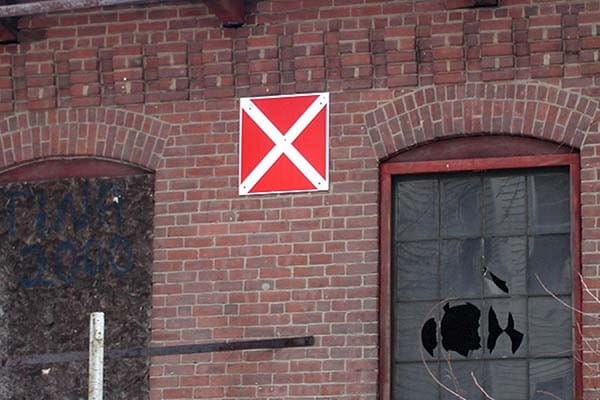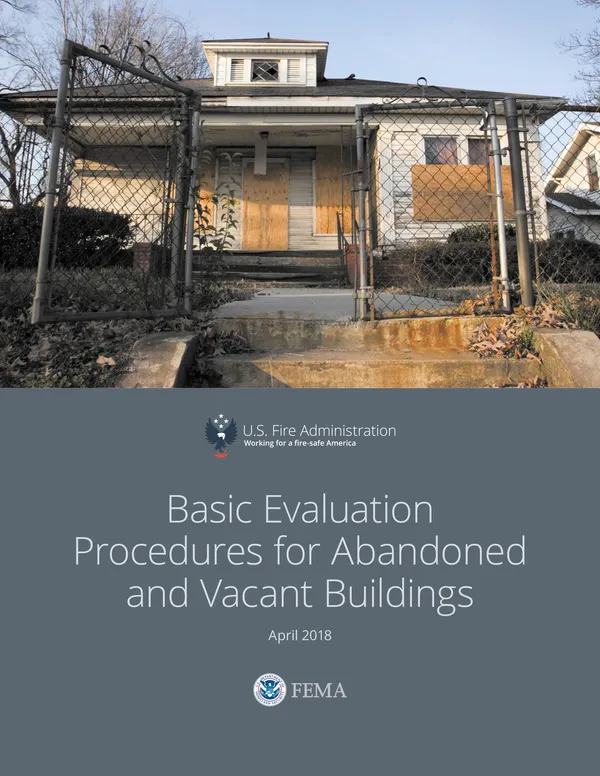Abandoned and vacant structures can be extremely treacherous to firefighters as they lack structural integrity and may contain other hazards.
Did you know:
There are 4 actions communities can take to reduce the negative impact and blight associated with unsecured vacant and abandoned buildings and keep firefighters safe:
- Monitor
- Secure
- Inspect
- Mark
Vacant versus abandoned: What’s the difference?
The difference between vacant and abandoned buildings is primarily related to the availability of an owner.
Vacant
Unoccupied buildings with an owner who is interested in the property and easily contacted are considered vacant. A vacant building usually has current taxes.
Abandoned
A property is considered abandoned if there is no owner or the landlord is absent. In addition, the building taxes are not paid and the building is not legally occupied.
Buildings and homes can become vacant or abandoned for a multitude of reasons, including: destroyed in a disaster, foreclosure, failed business or disinvestment by the owners. Unfortunately, these structures attract illicit activity, such as drug use, vandals and prostitution.
Abandoned property is the most striking indication of neighborhood decline. Large-scale abandonment threatens the stability of neighborhoods and undermines the value of investments made by other property owners.
Actions to take: monitor, secure, inspect and mark
Monitor
Monitor all vacant properties. Properties that are secure and well-maintained, even though they are unoccupied, are not the problem. Those that have no viable owner and are unsecured and accessible to unauthorized entry require immediate attention to prevent fires and other criminal activity.
Secure
Keeping unauthorized occupants out of vacant and abandoned buildings is key to preventing fires. Unsecured vacant or abandoned buildings are intrinsically more dangerous than occupied structures.
Boarding buildings
While there are many ways to secure properties, this board up procedure PDF is one of the most effective. Done correctly and coupled with a surveillance program, buildings secured using this method are very difficult to enter. Using this method also makes buildings resistant to deterioration due to weather and other elements.
Security and surveillance
Where physical security is required, it must be done well to be effective. Once secured, the building must be patrolled with some frequency to make sure it remains secure. High visibility police patrols can also be effective. The effectiveness of security measures should be evaluated during building inspection.
Inspect
Inspect and evaluate vacant or abandoned buildings to identify potential safety issues that first responders would face if they responded to a fire. The evaluation data can also be used in the decision-making process when limited funds must be allocated to address the most significant problems.
The authority to inspect comes from building codes and ordinances adopted by the jurisdiction. It is important to check department policy and know what the inspector must do to legally enter a property.
Personnel assigned to inspect vacant or abandoned buildings should use extreme caution when entering and moving throughout these structures. Potential hazards for both inspectors and first responders include the following:
- Fall and trip hazards
- Hazardous materials on property
- Ongoing criminal activity
- Standing water in basements
- Vermin
- Unauthorized occupants
- Unstable structure
Inspectors should wear proper protective clothing and carry a radio and flashlight when operating in these buildings. It is always good practice to inform dispatch when you are entering and leaving a building so that they can account for your location should you need assistance.
Mark
Mark buildings after they are secured and inspected. This provides a visual cue to firefighters responding to a fire, indicating that the property is vacant, was evaluated and found to contain hazards to firefighters.
An example of a marking system is the one established in Worcester, Massachusetts, after the loss of 6 firefighters in the Cold Storage Building.
An X in the box on a building denotes that only exterior operations should be performed. Enter the dangerous building only if there is a known life hazard.
A single line in the box on a building denotes that any interior operations should be done using extreme caution.
An empty box on a building denotes that there was normal stability at time of marking.

An X in the box on a vacant building in Worcester, Massachusetts, tells firefighters to only perform exterior operations and not to enter the dangerous building — unless there is a known life hazard.
How to evaluate an abandoned or vacant building
“Basic Evaluation Procedures for Abandoned and Vacant Buildings” shows fire service officials how to collect information about an abandoned or vacant property that emergency responders can use to:
- Determine if the building is secure.
- Identify hazards that require immediate corrective action.
- Evaluate the fire growth potential of the building.
- Evaluate the potential for structural collapse.
- Identify conditions that could be hazardous to personnel.
The guide also gives you tips on how to spot indications of problems involving the site, the building and its contents.

